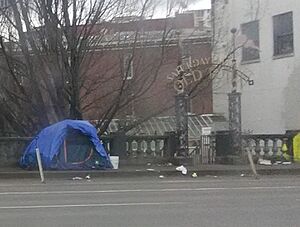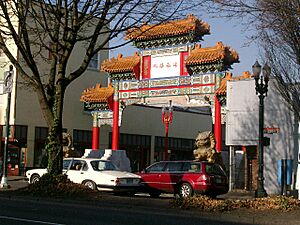Old Town Chinatown facts for kids
Quick facts for kids
Old Town Chinatown
|
|
|---|---|
|
Neighborhood
|
|
 |
|
| Country | United States |
| State | Oregon |
| City | Portland |
| Area | |
| • Total | 0.20 sq mi (0.53 km2) |
| Population | |
| • Total | 3,922 |
| • Density | 19,170/sq mi (7,400/km2) |
Old Town Chinatown is a historic and lively neighborhood in Portland, Oregon. It is officially recognized as Portland's Chinatown. The neighborhood is located in the northwest part of the city. The Willamette River forms its eastern edge. This river separates Old Town Chinatown from other areas like the Lloyd District.
The western border of the neighborhood is NW Broadway. This street separates it from the Pearl District. To the south, W Burnside Street marks the boundary with Downtown Portland. Old Town Chinatown includes two important historic areas. These are the Portland Skidmore/Old Town Historic District and the Portland New Chinatown/Japantown Historic District. Both are listed on the National Register of Historic Places.
Even though it's called Chinatown, many Chinese-Americans had moved out before the city officially named it in the 1980s. Property values went up after renovations. This caused more Chinese immigrants to move to other parts of Portland. A section of NE 82nd Avenue in East Portland became a new, unofficial Chinatown.
Contents
Getting Around Old Town Chinatown
This neighborhood is easy to get to using different types of transportation. Amtrak's Union Station is located in the northwest part of the area. This is where trains arrive and depart.
Three major bridges connect Old Town Chinatown to other parts of Portland. The Broadway Bridge is at the northern tip. The Steel Bridge and Burnside Bridge are along the eastern border.
MAX Light Rail Service
The MAX Light Rail system serves the neighborhood well. The train line enters the area from the Steel Bridge. It has stops at Old Town/Chinatown, Skidmore Fountain, and Oak Street/Southwest 1st Avenue. This light rail system connects the neighborhood to Northeast and North Portland across the Willamette River. It also connects to Downtown Portland to the south and west.
Bus and Transit Options
The Portland Mall starts near the Greyhound station. This mall provides local bus and light rail service. These lines run along 5th and 6th Avenues, heading south into downtown.
Exploring Historic Old Town
Old Town was the very first main part of Portland. It sits on both sides of West Burnside Street. It also includes an area under the Burnside Bridge. The Portland Skidmore/Old Town Historic District is a key part of Old Town Portland. This district was created in 1975. It is roughly bordered by Naito Parkway, Everett Street, 3rd Avenue, and Oak Street.
Popular Attractions in Old Town
There are many interesting places to visit in Old Town. The Saturday Market is a popular spot. Here you can find unique crafts, food, and entertainment. You can also explore the mysterious Shanghai tunnels. These tunnels are part of Portland's underground history.
Ankeny Square is another important site. It is home to Portland's oldest public artwork, the Skidmore Fountain. This beautiful fountain was dedicated on September 22, 1888. It was designed by Olin L. Warner from New York. The fountain is named after Stephen G. Skidmore, a pioneer druggist.
Revitalizing Old Town
Naito Parkway, which used to be called Front Avenue, is named after Bill Naito. He was a businessman and developer who worked in Old Town for a long time. In the 1960s, Bill Naito and his brother Sam Naito helped stop the decline of the area. They opened a retail store and bought and restored old buildings. They also encouraged others to invest in the district. Bill Naito passed away in 1996.
The New Market Block, located at 50 SW 2nd Ave, is an old six-story building with a lot of history. The Portland Skidmore/Old Town Historic District was recognized as a National Historic Landmark in 1977. This was because of its importance as a major port in the 1800s. It is also known for its collection of cast-iron commercial buildings.
Discovering Chinatown's Culture
The Chinatown part of Old Town stretches north from West Burnside Street to Union Station. The main entrance is marked by a beautiful China gate. This gate was built in 1986. It has a pair of lions and is located at the corner of NW 4th Avenue and W Burnside Street.
The central part of Chinatown was named the Portland New Chinatown/Japantown Historic District in 1989. This area goes from W Burnside Street to NW Glisan Street. It also spans from NW 5th Avenue to NW 3rd Avenue.
Chinatown Organizations and Features
Several important organizations have offices in Chinatown. These include the Port of Portland, the Oregon Department of Transportation's Portland offices, and NW Natural Gas. There is also a parking structure with a helipad on top.
Chinatown's Revitalization Efforts
A big step in bringing new life to the area was the opening of the Lan Su Chinese Garden on September 14, 2000. This beautiful park covers an entire city block. It cost $12.8 million to build. Sixty-five skilled artisans from Suzhou, China, built the garden using imported materials. All the plants, however, were grown locally.
More recently, NW 3rd and 4th Avenues were improved. They now have special plaques that describe historical features. Two "festival streets" were also created between these avenues. These streets are perfect for hosting street festivals. In 2008, Uwajimaya, a large Asian supermarket, was part of a plan to redevelop the area. This plan was similar to the Uwajimaya Village in Seattle's Chinatown-International District. It would have included the store, underground parking, apartments, and other small shops. People hoped it would bring more tourists and help the area thrive. However, in August 2011, Uwajimaya decided not to open a store in Chinatown.
In May 2021, the Old Town Chinatown Community Association voted to remove "Chinatown" from their name. This decision was led by their new chairperson, Jessie Burke. The newly named Old Town district stopped using "Chinatown" in official ways. It was even removed from official City of Portland tourism maps.
History of Japantown in Portland
Before World War II, the area now known as Chinatown was actually Portland's Japantown. Starting in the 1890s, many Japanese immigrants came through Portland. This created a need for hotels, bathhouses, and other services. Businesses in the city's Japantown grew in the affordable areas near the river. Before World War II, this Japantown in the Northwest District had over 100 businesses. It was the largest Japantown in Oregon.
Today, the Japanese American Historical Plaza and the Oregon Nikkei Legacy Center are in what is now Portland's Chinatown. These places serve as reminders of Portland's past Japantown.
Street Names in Chinese
The street signs in Chinatown have both English and Chinese names. The Chinese writing uses traditional characters. The pronunciation is in Cantonese.
- W Burnside Street — 西本世街
- NW Couch Street — 西北葛珠街
- NW Davis Street — 西北戴維斯街
- NW Everett Street — 西北愛和烈街
- NW Fifth Avenue — 西北第五街
- NW Flanders Street — 西北芬蘭達士街
- NW Fourth Avenue — 西北第四街
- NW Glisan Street — 西北紀利臣街
- NW Third Avenue — 西北第三街
Images for kids




